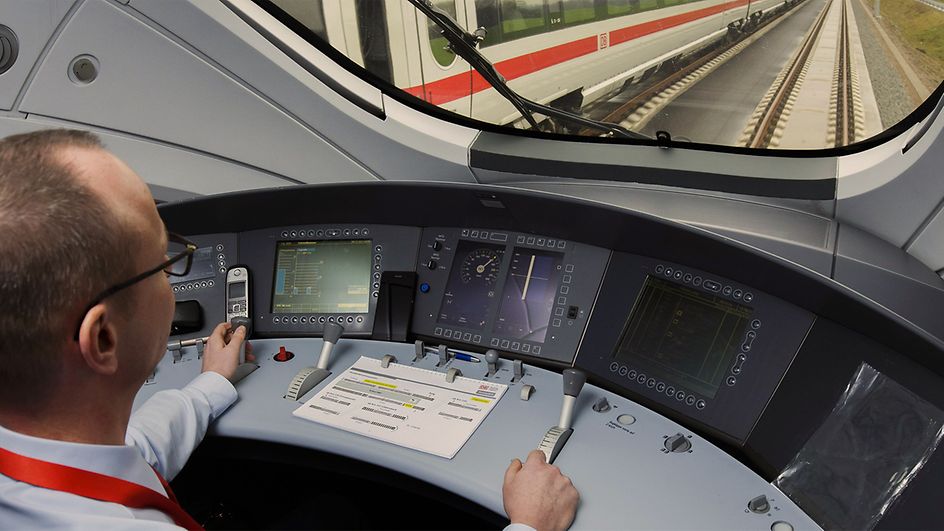Uniform data management and simpler billing
Article: An IT strategy becomes the timetable for the digitalisation of train path sales
09/2023 – DB Netz's sales department has renewed its IT landscape and processes – with the support of an IT strategy from DB Systel. DB Netz has now revamped its sales systems on the basis of concrete proposals to meet current and future requirements.
The same applies to an ICE operated by DB Fernverkehr as to an excursion by a historic steam locomotive from a railway museum: all journeys on the DB Netz rail network have to be booked. Long distance trains, freight trains and regional trains, etc. cover more than one billion kilometres per year on the 34,000 kilometres of track. DB Netz has more customers than you might think: around 450 different transport companies use the DB Netz tracks.
How trains get on the track
Train paths are the most important DB Netz product by far: transport companies reserve a time slot on the route to allow a train to travel to its destination. DB Netz also offers service facilities, for example stabling sidings for trains together with any necessary water supply, compressed air or electricity while stationary. A large part of the rail network's capacity is allocated on a longer-term basis through framework agreements and annual planning and is recorded in the working timetable so that timetables and regular connections can work reliably. The train path allocation system must be non-discriminatory and take numerous aspects into account, which makes seemingly simple orders somewhat complicated. Any remaining capacity on the railways can also be booked at any time with only about one day's notice.

All of this means that DB Netz needs a flexible system landscape for its sales department – from ordering through to the billing of these increasingly complicated orders – to be able to map uniform processes that are viable for the future. They need to be simpler for the back office staff and simpler for customers' planning and accounting departments. However, some systems in DB Netz's sales department went back as far as the 2000s and did not allow for end-to-end processes, including timetable systems and databases that were created in programming languages no longer taught at any university. There were also home-made Excel solutions and other tools. Even the master data of the hundreds of customers and even more numerous contact persons were not stored uniformly across all systems. One thing was clear: in the future, this system landscape would no longer be able to keep up with requirements.
"We were pioneers in business unit documentation at DB Netz. To be able to summarise such complexity and say these are our capacities and to realise them we will have to produce this particular software in the next few years."

Modernising the sale of infrastructure
That was 2019. Today, the system landscape in the DB Netz sales department looks completely different. The starting point was a new IT strategy. For VerITAS, the "Sales IT Analysis and Strategy", DB Systel evaluated the status at the time and identified capacities needed in the future: "What business capacities will I need as a business unit in five years' time in order to secure the business?" is how Michael Schultz-Wildelau from DB Systel summarises the strategy's initial questions. He developed this strategy with his team. "Product development, ordering and billing of the products. These are the key issues that were examined," says Ralph Grassel from DB Netz, who commissioned this new strategy.
Where there used to be Excel spreadsheets, system breaks and numerous manual interventions between the ordering and billing of services, today's systems work in a network and are much more effective. They utilise automation, allow better customer communication and offer employees and customers alike additional functions that provide more convenience, save time and avoid errors. The centrepieces of this renewal are the new Customer Relationship Management (CRM) software with additional marketing and communication solutions and a new billing system.
"This is essentially about customer portals – access to the products," says Ralph Grassel, who is responsible for the digitalisation of sales. "But it's also about uniform customer master data for all systems and a variety of smaller tools that customers can use for planning purposes, such as the 'train path finder'." This enables customers to see whether they can register a train the way they wish before they order: for example, can a train with a length of 750 metres even run along the desired route?
Creating a clear IT timetable for transformation
At the start of the transformation in 2019, DB Netz looked for a team of experts to meet the demands of the future with a detailed analysis and planning basis for the years 2020 to 2024. The company opted for DB Systel's strategy experts from the "Digital Consulting" organisation. DB Systel started off by collating existing capacities and processes.
Following the subsequent inventory of all current software tools, DB Systel evaluated this existing system landscape in terms of future vulnerabilities and gaps. "We were in constant communication with those responsible and with the relevant experts. The more concrete the measures became, the more DB Systel expertise we called in for the potential solutions," says Michael Schultz-Wildelau, describing the procedure of the DB Systel consulting team: "The result was a list of measures and a roadmap that DB Netz could also use to plan the budget for this period."
"We made our documented results available to many other organisations and also gave presentations to show how we actually did it. Many have adapted some of the ideas for their own business unit strategies."

What needs to be done and what will it cost?
In the detailed analysis and strategy, Ralph Grassel received the right tool to be able to plan the following years and act accordingly: "After completion of the strategy, everything became transparent to us. Although a lot of people knew a lot of things, there was no one place where it was all documented. On top of that, with a very clear prioritisation by the stakeholders." The concrete formulation of its requirements enabled DB Netz's sales department to specifically target its planning and budgeting: "At many moments in the following five years, this strategy was the basis for discussion to show those responsible for the budget that 'the money is needed for precisely this goal, and if we don't do this now, it will have the following consequences'. Because it clearly was documented in the strategy," the sales manager is pleased to report.
With the help of the strategy and the resulting IT solutions, DB Netz has taken a decisive step towards achieving its goal of improving the digital ordering of services and simplifying billing. Another important point in this new IT strategy was speeding up software development. With the previous development cycles, adjustments and new features simply took too long. Being a highly regulated company, DB Netz must be able to react at any time not only to customer requests but also, for example, to changes in the law. Now DB Netz's IT is produced using SAFe methodology ("Scaled Agile Framework"), an agile method for planning and development. As Ralph Grassel confirms: "That made the strategy a significant supporting factor in transforming how we produce IT."
"With this analysis, we have worked out how to address vulnerabilities and gaps we have identified in a five-year plan. It summarised vulnerabilities in fields of action as a basis for proposing measures that would remedy these vulnerabilities within five years."

To the next five years
"We have implemented many points from the strategy and did not deviate from the strategic sequence. We have also changed the way we produce IT," sums up the person responsible for the digitalisation of sales. Now, together with the DB Systel consulting team, DB Netz is already launching the IT strategy for the next five years: VerITAS 2.0. "As a business unit, we have recognised that this is a very good instrument," says Ralph Grassel. He added that the next stage would be to implement further IT capabilities and adapt IT needs to new circumstances in the business units, bearing in mind that sales and product management had also developed functionally and internal structures had changed in the last five years.
"We will also look into how current technology trends (for example, use of AI, chatbots) can help us to reduce the use of resources to streamline existing processes in terms of costs and to counteract the demographic trend," argues Ralph Grassel concerning the future of sales digitalisation. Michael Schultz-Wildelau has noticed that the functional departments are now even more open than before in the interviews with DB Systel: "We notice a clearer willingness to cooperate on the part of everyone involved. That is because they recognised it wasn't just some strategy we had come up with, and they saw what could be done with it and what the benefits of that strategy were."


